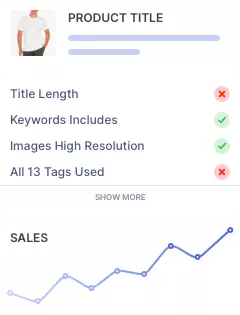2024 Step-by-Step Opening an Etsy Shop: Guide
Opening an Etsy shop is a great way to turn your passion for crafting, designing, or collecting into a business. Are you ready to take the leap and open your very own Etsy shop? The process can seem daunting, but with this step-by-step guide, creating an Etsy shop has been easier. With thousands of online storefronts on the international marketplace, Etsy is the perfect platform to showcase your unique items and make sales.

In this guide, we will walk you through the step-by-step process of creating an Etsy shop, from choosing your shop name to making your first sale and sustaining your business long-term. We have tried every feature and explored every nook and cranny of the e-commerce platform to help you spend less time setting up shop and more time making. By the end of this guide, you will have a clear understanding of how to open an Etsy shop and make it a success. So, Let’s get started to create an Etsy shop.
Do You Know In Detail About Etsy?
Etsy is an e-commerce website focused on handmade or vintage items and craft supplies. It was founded in 2005 and allows individuals and small businesses to sell their products online. It has grown to become a large marketplace with over 60 million listings and gross merchandise sales of nearly $4 billion. It is known for offering unique and one-of-a-kind items that can’t be found on other e-commerce platforms.
What Can You Sell On Etsy?
Etsy is a platform for selling handmade or vintage goods. Handmade items can include products that you have designed or created yourself, such as clothing, jewelry, or home decor. The items you sell don’t necessarily have to be made entirely by hand, as long as they are original and unique. You can also sell digital products such as designs or patterns that customers can download immediately. As long as the product is something you have created, it can be sold on Etsy.
4 Things To DO Before Starting An Etsy Shop
Before creating an Etsy shop, we have to first discuss our skills and abilities, which will make your store prominent in the Online world of Etsy.
Which Product Will You Sell?
When starting an Etsy shop, it’s important to consider what items you want to sell. Look at your current creations and decide which ones you would like to offer on the platform. You can start by listing a few items and gradually expanding your offerings. If you plan to sell items that can be replicated, make sure that you can easily and efficiently create multiple versions of them. Additionally, you also have the option to sell unique or one-of-a-kind items in your shop.
Have You Done Your Research?
Once you have a product or products in mind to sell on Etsy, it’s important to do some research to understand the marketplace. Use the Etsy search bar to look for similar products and take note of the prices and what shops are selling them. This will give you an idea of what’s already out there and help you find ways to stand out from the competition. One way to do this is by finding a niche for your product. Generic products can get lost among a sea of similar listings, so the more specific and unique your product is, the more visible it will be to potential customers. Look at your own analytics and see which items are getting the most attention.
What Is The Name Of Your Brand?
Branding is the way a company or product defines its identity or personality. This includes the look, feel, and story of the brand, which helps to separate it from other products. When creating a brand for your Etsy store, it’s important to establish a logo, color scheme, and tone for your written copy that tells shoppers about your shop without actually telling them. Your store’s name can be fun, funny, or simple, but it’s important to choose a unique URL that reflects the store name in some way, even if the store name itself is already taken. The key is to be creative and make it work for you.
Which Logo And Banner Image Did You Create For Your Brand?
Creating a logo is a simple and effective way to improve the overall appearance of your brand. It can make your business seem more professional and polished. There are many online tools available that allow you to easily create a logo without any prior design experience, such as Wix, and Logo.com. Additionally, when setting up your online shop, you may be prompted to upload a banner image that will be displayed at the top of your page.
Steps To Follow To Create An Etsy Shop
Creating an account:
To create a seller account on Etsy, you will first need to have a consumer account. Go to the “Sign In” button located in the top right corner of the page and enter your account information or sign up for a new account. After you have confirmed your account through the email sent to you, look for a gray circle with a silhouette on it, next to the shopping cart in the top right corner. Click on this circle, and a drop-down menu will appear. Select “Sell on Etsy” to start creating your seller account.
Input your preferred shop settings:
Please provide me with your language, country, currency, and whether or not your shop is your main source of income. Once you have entered this information, click the “Save and Continue” button in the bottom right corner.
Give A Name To Your Shop:
You must choose a unique name for your shop that is 20 characters or less, containing only unaccented letters and numbers without spaces. Once you have chosen a name, you can only change it once, so it is important to choose carefully. You can check for the availability of the name you have chosen and there are tips available for choosing a shop name on Etsy. After you have decided on a name, you can proceed to the next step by clicking “save and continue.”
It’s Time To Create Lists:
When creating your listings on Etsy, it’s recommended to have a minimum of ten different listings for better visibility. Each listing should include photos, with at least one photo required and up to ten photos allowed. In addition to product images, it’s helpful to include a picture of the product next to a ruler or dollar bill to help customers gauge the size of the item. While not required, videos can set your product apart and should show the product in use and at all angles.
Listing details should include the title of the product, who made it when it was made, whether it’s a physical or digital product, a detailed description, materials used, and tags. Additionally, you can add a section to group like products together. In the inventory and pricing section, you should list the price of the item and make sure to factor in the cost of materials, labor, shipping cost, and shipping materials. If you follow the best manufacturing processes, you can also include an SKU. If your product has multiple sizes or colors, you should list them under product variations.
If you offer personalization on your products, you should select “on” under personalization, otherwise, keep it “off”. In the shipping section, you can have Etsy calculate your shipping costs based on your original zip code. Input your processing time, where you’re willing to ship, shipping services offered, whether you include free domestic or international shipping, and whether you want to build a handling fee into the shipping price. The item weight and size should also be included in this section. You should review each listing before saving it, and once you’ve added all of your listings, select “save and continue.”
Enter Your Payment Configuration:
Etsy requires information about your tax filing status in order to set up your payment settings. If you are an individual or sole proprietor, you will need to provide your country, full name, date of birth, address, phone number, and the last four digits of your social security number.
If you are a registered legal entity, you will need to provide the name of the legal entity, legal business address, state, business registration number, and EIN. Additionally, Etsy will ask for a primary contact for the business, requiring their full name, address, date of birth, and the last four digits of their Social Security number. After completing this section, you will need to provide information about the location of your bank and your routing and account numbers for your sales to be deposited.
Enter all the details of your credit card:
As an Etsy seller, there are three main types of fees that you may encounter: listing fees, transaction fees, and payment processing fees (if using Etsy Payments). To pay these fees, you will need a credit card. You can input your credit card information, including the number, CCV, expiration date, and full name on the card, on Etsy’s website. To make things more convenient, you can also sign up for auto-billing, which will automatically bill your card on the first of the month or when you reach your fee threshold. If you prefer to pay manually, you can do so anytime between the first and 15th of the month.
Shop opening:
Once you have entered your credit card information, the “Open Your Shop” button will become active and you can click on it. This means your shop is now open. You can then share the link to your shop with your friends, family, and followers. Your shop has two different URL formats available: one for sharing and another for editing.
Write your Bio:
Include a brief bio and photo to personalize your shop and showcase the artisan behind it. Share your inspiration for creating your products, such as raising funds for a specific cause or financing a journey like IVF or adoption.
Establish your store’s guidelines:
In order to effectively operate as an Etsy seller, it is important to anticipate any potential questions or concerns a buyer may have and address them in a clear and comprehensive manner. One way to do this is by including a detailed policy section in your shop. Some essential elements to include in your shop policies are:
- Processing time: The amount of time it takes for you to prepare and ship an order.
- Shipping policies: The methods and carriers you use for shipping, as well as any additional options such as insurance.
- Payment options: The forms of payment you accept, such as credit card, PayPal, etc.
- Returns and exchanges policy: The conditions under which you will.
Your Etsy Shop Is Ready:
Congratulations, your Etsy shop is now open and ready for business! You have taken the first step in creating your online presence and reaching a global audience. Make sure to take the time to optimize your listings with high-quality images and detailed descriptions to showcase your products in the best possible light. Utilize the various tools and resources available on Etsy to promote your shop and reach new customers. Keep in mind that it takes time to build a successful business, but with hard work and persistence, you can turn your passion into a thriving enterprise. Good luck!
Conclusion:
In conclusion, opening an Etsy shop in 2024 can be a great way to start your own business and sell your unique products to a global audience. However, it can be challenging to navigate the platform and make your shop stand out among the competition. Roketfy offers a variety of tools to help you succeed on Etsy, including the Roketfy Listing Checker, which analyzes your shop’s performance and provides actionable insights for improvement. The Roketfy AI Writer Tool is also helpful for crafting compelling product descriptions and titles. With the help of these tools, you can increase your visibility on Etsy and grow your business.



